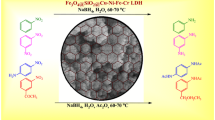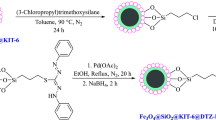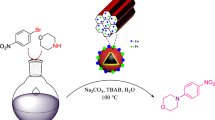Abstract
In this article the preparation of Fe3O4@MCM-41@NH-SO3H, a new sulfonated magnetic mesoporous nanocomposite, is reported. The introduced catalyst is structurally based on MCM-41 as the mesoporous support in which besides having all the unique properties, has a limited acidity so its catalytic strength was favorably improved via acidic functionalization as an applicable and efficient procedure. The accuracy of the specified formula attributed to the synthesized nanocomposite was verified using FT-IR, XRD, BET, TEM, VSM and TGA techniques and also pH analysis. In continue, the influence of this reagent on the formyl protection of amines and alcohols was investigated. As predicted, Fe3O4@MCM-41@NH-SO3H showed considerable efficiency in the promotion of the studied reactions.
Similar content being viewed by others
References
Jackson A, Meth-Cohn O (1995) A new short and efficient strategy for the synthesis of quinolone antibiotics. J Chem Soc Chem Comm 13:1319–1319
Chen B-C, Bednarz MS, Zhao R, Sundeen JE, Chen P, Shen Z, Skoumbourdis AP, Barrish JC (2000) A new facile method for the synthesis of 1-arylimidazole-5-carboxylates. Tetrahedron Lett 41(29):5453–5456
Kobayashi K, Nagato S, Kawakita M, Morikawa O, Konishi H (1995) Synthesis of 1-formyl-1,2-dihydroquinoline derivatives by a lewis acid-catalyzed cyclization of o-(1-hydroxy-2-alkenyl)phenyl isocyanides. Chem Lett 24(7):575–576
Pettit G, Kalnins M, Liu T, Thomas E, Parent K (1961) Notes- potential cancerocidal agents. III formanilides. J Org Chem 26(7):2563–2566
Iseki K, Mizuno S, Kuroki Y, Kobayashi Y (1999) Asymmetric allylation with chiral formamide catalysts. Tetrahedron 55(4):977–988
Downie IM, Earle MJ, Heaney H, Shuhaibar KF (1993) Vilsmeier formylation and glyoxylation reactions of nucleophilic aromatic compounds using pyrophosphoryl chloride. Tetrahedron 49(19):4015–4034
Martinez J, Laur J, Castro B (1985) On the use of carboxamidomethyl esters (cam esters) in the synthesis of model peptides. Scope and limitations. Tetrahedron 41(4):739–743
Ahrens M (2008) Literature review of organic Chemicals of Emerging Environmental Concern in use in Auckland. Auckland Regional Council
Collins DE, Richey FA (1992) Synthetic organic chemicals. In: Kent JA (ed) Riegel’s handbook of industrial chemistry. Springer US, Boston, MA, pp 800–862. https://doi.org/10.1007/978-1-4757-6431-4_22
Olah GA, Ohannesian L, Arvanaghi M (1987) Formylating agents. Chem Rev 87(4):671–686
Zeynizadeh B, Abdollahi M (2016) The immobilized NaHSO4· H2O on activated charcoal: a highly efficient promoter system for N-formylation of amines with ethyl formate. Curr Chem Lett 5(2):51–58
Ma’mani L, Sheykhan M, Heydari A, Faraji M, Yamini Y (2010) Sulfonic acid supported on hydroxyapatite-encapsulated-γ-Fe2O3 nanocrystallites as a magnetically Brønsted acid for N-formylation of amines. Appl Catal, A 377(1):64–69
Shirini F, Zolfigol MA, Safari A (2006) Efficient acetylation and formylation of alcohols in the presence of Zr(HSO4)4. J Chem Res 2006(3):154–156
Tumma H, Nagaraju N, Reddy KV (2009) A facile method for the N-formylation of primary and secondary amines by liquid phase oxidation of methanol in the presence of hydrogen peroxide over basic copper hydroxyl salts. J Mol Catal A Chem 310(1):121–129
Bahari S, Mohammadi-Aghdam B, Sajadi SM, Zeidali F, petrochemical Complex I (2012) An efficient method for N-formylation of amines using natural HEU zeolite at room temperature under solvent-free conditions. Bull Kor Chem Soc 33 (7):2251, 2254
Ram RN, Meher NK (2002) Selective formylation of alcohols in the presence of phenols with chloral. Tetrahedron 58(15):2997–3001
Firouzabadi H, Iranpoor N, Farahi S (2008) Solid trichlorotitanium(IV) trifluoromethanesulfonate TiCl3(OTf) catalyzed efficient acylation of –OH and –SH: direct esterification of alcohols with carboxylic acids and transesterification of alcohols with esters under neat conditions. J Mol Catal A Chem 289(1):61–68
Mirkhani V, Tangestaninejad S, Moghadam M, Yadollahi B, Alipanah L (2004) Cerium polyoxometalate as a reusable catalyst for acetylation and formylation of alcohols. Monatsh Chem 135(10):1257–1263
Lu GQ, Zhao XS (2004) Nanoporous materials : science and engineering. Imperial College Press, London. https://doi.org/10.1142/p181
Tully PS (2005) Sulfonic acids. Van Nostrand's Encyclopedia of Chemistry, New York
Clark HJ (1999) Green chemistry: challenges and opportunities. Green Chem 1(1):1–8
Gupta P, Paul S (2014) Solid acids: green alternatives for acid catalysis. Catal Today 236:153–170
Mohammadi Ziarani G, Badiei AR, Khaniania Y, Haddadpour M (2010) One pot synthesis of polyhydroquinolines catalyzed by sulfonic acid functionalized SBA-15 as a new nanoporous acid catalyst under solvent free conditions. Iran J Chem Chem Eng 29(2):1–10
Li C, Yang J, Wang P, Liu J, Yang Q (2009) An efficient solid acid catalyst: poly-p-styrenesulfonic acid supported on SBA-15 via surface-initiated ATRP. Microporous Mesoporous Mater 123(1):228–233
Zareyee D, Ghandali MS, Khalilzadeh MA (2011) Sulfonated ordered Nanoporous carbon (CMK-5-SO3H) as an efficient and highly recyclable catalyst for the Silylation of alcohols and phenols with Hexamethyldisilazane (HMDS). Catal Lett 141(10):1521–1525
Bandyopadhyay M, Shiju NR, Brown DR (2010) MCM-48 as a support for sulfonic acid catalysts. Catal Commun 11(7):660–664
Suganuma S, Nakajima K, Kitano M, Kato H, Tamura A, Kondo H, Yanagawa S, Hayashi S, Hara M (2011) SO3H-bearing mesoporous carbon with highly selective catalysis. Microporous Mesoporous Mater 143(2):443–450
Peng W-H, Lee Y-Y, Wu C, Wu KCW (2012) Acid–base bi-functionalized, large-pored mesoporous silica nanoparticles for cooperative catalysis of one-pot cellulose-to-HMF conversion. J Mater Chem 22(43):23181–23185
Zareyee D, Moosavi SM, Alaminezhad A (2013) Chemoselective synthesis of geminal diacetates (acylals) using eco-friendly reusable propylsulfonic acid based nanosilica (SBA-15-Ph-PrSO3H) under solvent-free conditions. J Mol Catal A Chem 378:227–231
Yiu HHP, Keane MA, Lethbridge ZAD, Lees MR, El Haj AJ, Dobson J (2008) Synthesis of novel magnetic iron metal–silica (Fe–SBA-15) and magnetite–silica (Fe3O4–SBA-15) nanocomposites with a high iron content using temperature-programed reduction. Nanotechnology 19(25):255606–255612
Yiu HHP, McBain SC, Lethbridge ZAD, Lees MR, Dobson J (2010) Preparation and characterization of polyethylenimine-coated Fe3O4-MCM-48 nanocomposite particles as a novel agent for magnet-assisted transfection. J Biomed Mater Res A 92A(1):386–392
Arab P, Badiei A, Koolivand A, Mohammadi Ziarani G (2011) Direct hydroxylation of benzene to phenol over Fe3O4 supported on nanoporous carbon. Chin J Catal 32(1):258–263
Haghighat M, Shirini F, Golshekan M (2018) Efficiency of NaHSO4 modified periodic mesoporous organosilica magnetic nanoparticles as a new magnetically separable nanocatalyst in the synthesis of [1,2,4]triazolo quinazolinone/pyrimidine derivatives. J Mol Struct 1171:168–178
Zabihzadeh M, Shirini F, Tajik H, Shokri Z, Karami AS (2020) Magnetic Fe3O4/graphene oxide/copper-based nanocomposite as a reusable catalyst for the reduction of 4-nitrophenol. J Nanosci Nanotechnol 20(1):121–127
Kobayashi Y, Horie M, Konno M, Rodríguez-González B, Liz-Marzán LM (2003) Preparation and properties of silica-coated cobalt nanoparticles. J Phys Chem B 107(30):7420–7425
Zhang M, Liu Y-H, Shang Z-R, Hu H-C, Zhang Z-H (2017) Supported molybdenum on graphene oxide/Fe3O4: an efficient, magnetically separable catalyst for one-pot construction of spiro-oxindole dihydropyridines in deep eutectic solvent under microwave irradiation. Catal Commun 88:39–44
Pourhasan-Kisomi R, Shirini F, Golshekan M (2018) Introduction of organic/inorganic Fe3O4@MCM-41@Zr-piperazine magnetite nanocatalyst for the promotion of the synthesis of tetrahydro-4H-chromene and pyrano[2,3-d]pyrimidinone derivatives. Appl Organomet Chem 32(7):4371–4389
Pourhasan-Kisomi R, Shirini F, Golshekan M (2019) Organic/inorganic Fe3O4@MCM-41@Zr-Piperazine: an impressive magnetite nanocatalyst for N-tert-butoxycarbonylation of amines. J Nanosci Nanotechnol 19(7):3859–3870
Makhsous M, Shirini F, Seddighi M, Mazloumi M (2018) Efficient synthesis of pyrimido[1,2-a]Benzimidazoles and ethyl pyrimido[1,2-a]benzimidazole-3-carboxylates using brönsted acidic ionic liquid supported on nanoporous Na+−montmorillonite. Polycycl Aromat Comp:1–8
Shirini F, Mazloumi M, Seddighi M (2018) Facile and efficient synthesis of tetrahydrobenzimidazo [2,1-b]quinazolin-1(2H)-one derivatives using brönsted acidic ionic liquid immobilized on nanoporous Na+−montmorillonite. J Nanosci Nanotechnol 18(2):1194–1198
Haghighat M, Shirini F, Golshekan M (2019) Synthesis of tetrahydrobenzo[b]pyran and pyrano[2, 3-d]pyrimidinone derivatives using Fe3O4@Ph-PMO-NaHSO4 as a new magnetically separable nanocatalyst. J Nanosci Nanotechnol 19(6):3447–3458
Shirini F, Langarudi MSN, Daneshvar N (2017) Preparation of a new DABCO-based ionic liquid [H2-DABCO][H2PO4]2 and its application in the synthesis of tetrahydrobenzo[b]pyran and pyrano[2,3-d]pyrimidinone derivatives. J Mol Liq 234:268–278
Karimi-Chayjani R, Daneshvar N, Tajik H, Shirini F (2019) Introduction of a new magnetic nanocatalyst as an organic-inorganic hybrid framework for the synthesis of pyrano[2,3-d]pyrimidinone(thione)s and pyrido[2,3-d]pyrimidines. Chemistry Select 4(4):1205–1213
Haghighat M, Golshekan M, Shirini F (2019) Periodic mesoporous organosilica containing bridged N-sulfonic acid groups: promotion of the synthesis of N,N’-diarylformamidines, benzoxazoles, benzothiazoles and benzimidazoles. ChemistrySelect 4(27):7968–7975
Chen M-N, Mo L-P, Cui Z-S, Zhang Z-H (2019) Magnetic nanocatalysts: synthesis and application in multicomponent reactions. Current Opinion Green Sustainable Chem 15:27–37
Gao G, Di J-Q, Zhang H-Y, Mo L-P, Zhang Z-H (2020) A magnetic metal organic framework material as a highly efficient and recyclable catalyst for synthesis of cyclohexenone derivatives. J Catal 387:39–46
Saadatjoo N, Golshekan M, Shariati S, Kefayati H, Azizi P (2013) Organic/inorganic MCM-41 magnetite nanocomposite as a solid acid catalyst for synthesis of benzo[α]xanthenone derivatives. J Mol Catal A Chem 377:173–179
Golshekan M, Shariati S, Saadatjoo N (2014) The synthesis of aminonaphtols and β-amino carbonyls in the presence of a magnetic recyclable Fe3O4@MCM-48–NaHSO4 nano catalyst. RSC Adv 4(32):16589–16596
Dutta MM, Rajbongshi KK, Phukan P (2017) CoFe2O4–SiO2–SO3H nanocomposite as a magnetically recoverable catalyst for oxidative bromination of alkynes. Synth Commun 47(24):2330–2341
Ghafoor S, Ata S (2017) Synthesis of carboxyl-modified Fe3O4@SiO2 nanoparticles and their utilization for the remediation of cadmium and nickel from aqueous solution. J Chil Chem Soc 62(3):3588–3592
Xie W, Zang X (2016) Immobilized lipase on core–shell structured Fe3O4–MCM-41 nanocomposites as a magnetically recyclable biocatalyst for interesterification of soybean oil and lard. Food Chem 194:1283–1292
Wamba AGN, Kofa GP, Koungou SN, Thue PS, Lima EC, dos Reis GS, Kayem JG (2018) Grafting of amine functional group on silicate based material as adsorbent for water purification: a short review. J Environ Chem Eng 6(2):3192–3203
Nemati F, Heravi MM, Saeedi Rad R (2012) Nano-Fe3O4 encapsulated-silica particles bearing sulfonic acid groups as a magnetically separable catalyst for highly efficient Knoevenagel condensation and Michael addition reactions of aromatic aldehydes with 1,3-cyclic Diketones. Chin J Catal 33(11):1825–1831
Aliahmad M, Moghaddam NN (2013) Synthesis of maghemite (γ-Fe2O3) nanoparticles by thermal-decomposition of magnetite (Fe3O4) nanoparticles. Mater Sci-Poland 31(2):264–268
Parangi TF, Patel RM, Chudasama UV (2014) Synthesis and characterization of mesoporous Si-MCM-41 materials and their application as solid acid catalysts in some esterification reactions. Bull Mater Sci 37(3):609–615
Nikoorazm M, Ghorbani F, Ghorbani-Choghamarani A, Erfani Z (2018) Nickel Schiff base complex anchored on Fe3O4@MCM-41 as a novel and reusable magnetic nanocatalyst and its application in the oxidation of sulfides and oxidative coupling of thiols using H2O2. Phosphorus Sulfur Silicon Relat Elem 193(9):552–561
Hajjami M, Ghorbani F, Bakhti F (2014) MCM-41-N-propylsulfamic acid: an efficient catalyst for one-pot synthesis of 1-amidoalkyl-2-naphtols. Appl Catal, A 470:303–310
Zhang J (2018) Amino-modified molecular sieves for adsorptive removal of H2S from natural gas. RSC Adv 8(66):38124–38130
Chen T, Peng X, Dai H (2016) Construction of site-specific core–shell structured nanocomposite for pH-controlled drug delivery. J Porous Mater 23(4):987–995
Bandyopadhyay M, Tsunoji N, Sano T (2017) Mesoporous MCM-48 immobilized with Aminopropyltriethoxysilane: a potential catalyst for Transesterification of Triacetin. Catal Lett 147(4):1040–1050
Seddighi M, Shirini F, Mamaghani M (2015) An efficient method for the synthesis of formamidine and formamide derivatives promoted by sulfonated rice husk ash (RHA-SO3H). J Iran Chem Soc 12(3):433–439
Shirini F, Mazloumi M, Seddighi M (2016) Acidic ionic liquid immobilized on nanoporous Na+−montmorillonite as an efficient and reusable catalyst for the formylation of amines and alcohols. Res Chem Intermed 42(3):1759–1776
Brahmachari G, Laskar S (2010) A very simple and highly efficient procedure for N-formylation of primary and secondary amines at room temperature under solvent-free conditions. Tetrahedron Lett 51(17):2319–2322
Yarie M (2017) Catalytic anomeric based oxidation. Iran J Catal 7(1):85–88
Zolfigol MA, Khazaei A, Alaie S, Baghery S, Maleki F, Bayat Y, Asgari A (2016) Experimental and theoretical approving of anomeric based oxidation in the preparation of 2-sbstituted benz-(imida, oxa and othia)-zoles using [2,6-DMPy-NO2]C(NO2)3 as a novel nano molten salt catalyst. RSC Adv 6(63):58667–58679
Acknowledgements
We are thankful to the Research Council of the University of Guilan for the partial support of this research.
Availability of Data and Material
The data and material are available within the manuscript.
Funding
This work did not receive a financial support.
Author information
Authors and Affiliations
Contributions
Conceptualization: Pourhasan-Kisomi R. and Golshekan M., Methodology, Writing - original draft preparation and Formal analysis and investigation: Pourhasan-Kisomi R., Writing - review and editing: Pourhasan-Kisomi R. and Shirini F., Supervision: Shirini F.
Corresponding author
Ethics declarations
Conflict of Interest
The authors declare that they have no conflict of interest.
Consent to Participate
Not applicable.
Consent for Publication
Not applicable.
Additional information
Publisher’s Note
Springer Nature remains neutral with regard to jurisdictional claims in published maps and institutional affiliations.
Rights and permissions
About this article
Cite this article
Pourhasan-Kisomi, R., Shirini, F. & Golshekan, M. Fe3O4@MCM-41@NH-SO3H: an Efficient Magnetically Reusable Nano-Catalyst for the Formylation of Amines and Alcohols. Silicon 14, 2583–2594 (2022). https://doi.org/10.1007/s12633-021-01000-y
Received:
Accepted:
Published:
Issue Date:
DOI: https://doi.org/10.1007/s12633-021-01000-y




